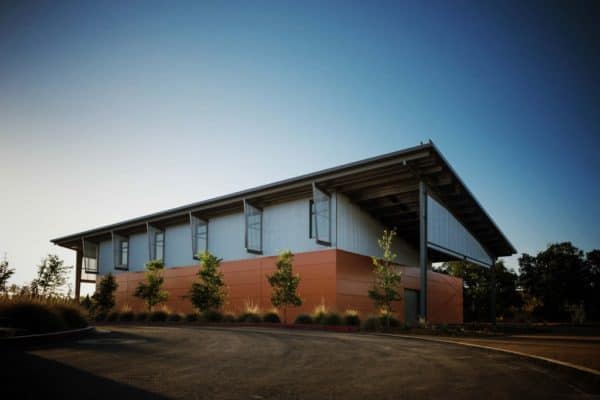Halifax-based CarbonCure brings sustainability to California’s wine industry


On May 29th, Halifax-based CarbonCure Technologies celebrated a significant milestone with the christening of the 8,500-square-foot Jess S. Jackson Winery Building in Davis, California.
Located on the grounds of the University of California Davis, the structure was brought into being by the team of Pankow Builders and Siegel & Strain Architects, and is only the second building so far to be certified Net Zero Energy under the Living Building Challenge in California.
Halifax-based CarbonCure Technologies was founded in 2007, it says, to lead a market movement towards towards affordable green concrete. The technology, which works by permanently absorbing waste CO2 into precast concrete, is now rolling out through plant demonstrations across North America.
Summer temperatures of 102°F aren’t unusual in Davis, so the building’s design strategy encompassed its orientation and form, and a super-insulated envelope for self-cooling, as well as the use of thermal mass to help cool the building throughout the day and natural ventilation to flush the building at night.
“Form and materials are used in the JSWB to help the building fit into the campus context as well as to enhance performance,” said Nancy Malone, Principal and Lead Designer with Siegel & Strain. “It includes a number of forward-thinking features and technologies that highlight what’s possible with sustainable, passive building design.”
Deep porches at the east and west facades shade the building and provide reduced heat island effect. The roof was designed to accommodate a photovoltaic array, with space for an expansion of up to 272 additional panels to offset future energy usage of equipment installed in the building by the owner or to offset power needs of the adjacent building. 2500 concrete masonry units, made using CarbonCure technology, permanently sequesters waste carbon dioxide.
The CarbonCure blocks were combined with the first usage of Central Concrete Supply’s cement replacement mix. The cement industry is one of the largest emitters of carbon dioxide and thereby of greenhouse gases, not to mention that concrete contributes greatly to the urban heat island effect. CarbonCure Technologies has produced a concrete that permanently sequesters CO2 instead.
“Central Concrete appreciated working with such a forward-thinking design team, interested in pursuing innovative, sustainable product solutions for the Jess. S. Jackson Winery Building”, said Mike Donovan, Central Concrete Supply’s director of quality and assurance. “Our combined efforts resulted in us producing an extremely low CO2 concrete mix, with 90% cement replacement materials, for this project’s blockfill applications.”
The new building is adjacent to the university’s Teaching and Research Winery and August A. Busch III Brewing and Food Science Laboratory, both located at the Robert Mondavi Institute for Wine and Food Science complex just off Interstate 80.
Being a research facility as well as a winery, the building’s purpose is to explore ways to maximize water conservation in wine production and to sequester carbon dioxide during fermentation, with the ultimate goal of producing wine with a net-zero carbon footprint and the development of a model of sustainability for the larger wine industry.
“What you see in this building is the potential to achieve levels of sustainable operation never before seen in a commercial or research winery,” said David Block, chair of the UC Davis Department of Viticulture and Enology.
The new building at UC Davis will also be equipped to produce chilled water, using a solar-powered icemaker, and generate hydrogen gas by electrolysis, charging a hydrogen fuel cell for night-time energy use.

Terry Dawes
Writer
